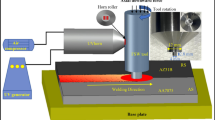Abstract
Dissimilar materials of 5052-O and 6061-T6 aluminum alloys are friction stir welded by arranging the material location and under various welding conditions. The metal flow phenomenon in friction stir welding comprises two modes of metal transfer. The first mode of metal transfer takes place layer by layer and it is caused by the shearing action of the tool shoulder, while the second mode is caused by the extrusion of the plasticized metal around the pin. The aim of the present study is to understand the metal flow by interchanging the base materials arrangement, namely advancing side and retreating side and its effect on mechanical properties. An image processing technique is used to determine the quantitative amount of the first mode. Effect of first mode of metal transfer on ultimate tensile strength and yield strength have been analyzed. This analysis shows that the first mode of metal transfer increases with increasing travel speed and reveals a substantial relationship between the mechanical properties and the first mode of metal transfer. Material mixing of the joints has been evaluated by using optical microstructure, scanning electron microscopy and energy-dispersive spectroscopy. Results of this analysis show that better material mixing and consequently improved mechanical properties are achieved when 5052 is placed on the advancing side.




Similar content being viewed by others
References
Weifeng X U, and Zhaoxi L I, J Mater Eng Perform 26 (2017) 1946.
Tongne A, Desrayaud M, Jahazi M, and Feulvarch E, J Mater Eng Perform 239 (2017) 296.
Muthukumaran S, and Mukherjee K, Sci Technol Weld Join 53 (2005) 1225.
Preetishsinha S, Muthukumaran S, and Mukherjee K, J Mater Process Technol 197 (2008) 21.
Amini K, and Gharavi F, J Cent South Univ 23 (2016) 1311.
Steuwer A, Peel M J, and Withers P J, Mater Sci Eng A 441 (2006) 196.
Palanivel R, Mathews P K, Murugan N, and Dinaharan I, Mater Des 40 (2012) 16.
Park S K, Hong S T, Park K Y, and Son H J, Sci Technol Weld Join 331 (2013)15.
Preetish S, Muthukumaran S, and Mukherjee Kumar S K, J Mater Process Technol 197 (2008) 21.
Cheepu M, Ashfaq M, and Muthupandi V, Trans Indian Inst Metals 70 (2017) 2591.
Muralimohan C H, Ashfaq M, Ashiri R, Muthupandi V, and Sivaprasad K, Metall Mater Trans A 47 (2016) 347.
Muralimohan C H, Muthupandi V, and Sivaprasad K, Procedia Mater Sci 5 (2014) 1120.
Cheepu M, and Che W S, J Weld Join 37 (2019) 46.
Muralimohan C H, Muthupandi V, and Sivaprasad K, Int J Mater Res 105 (2014) 350.
Cheepu M M, Muthupandi V, and Loganathan S, Mater Sci Forum 710 (2012) 620.
Author information
Authors and Affiliations
Corresponding author
Additional information
Publisher's Note
Springer Nature remains neutral with regard to jurisdictional claims in published maps and institutional affiliations.
Rights and permissions
About this article
Cite this article
Babu, K.T., Muthukumaran, S. & Kumar, C.H.B. The Role of Material Location on the First Mode of Metal Transfer and Weld Formation in Dissimilar Friction Stir Welded Thin Sheets. Trans Indian Inst Met 72, 1589–1592 (2019). https://doi.org/10.1007/s12666-019-01716-x
Received:
Accepted:
Published:
Issue Date:
DOI: https://doi.org/10.1007/s12666-019-01716-x




